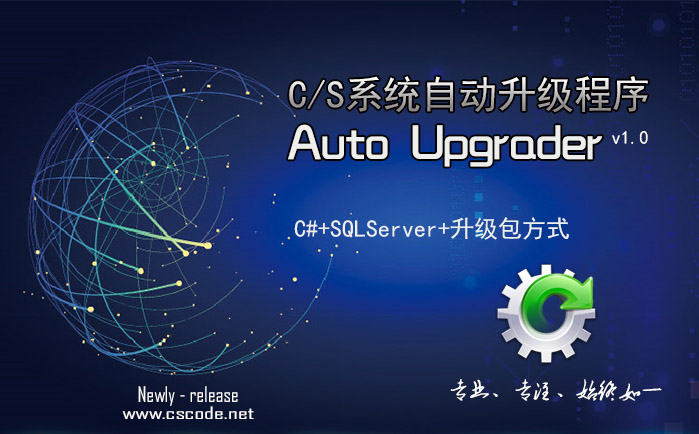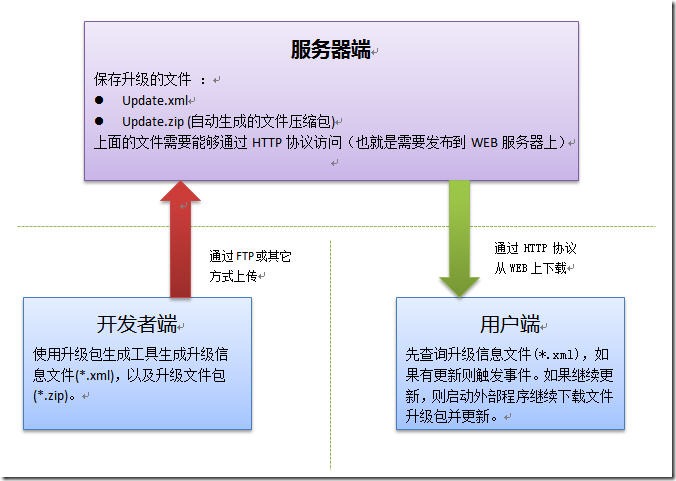winform程序相对web程序而言,功能更强大,编程更方便,但软件更新却相当麻烦,要到客户端一台一台地升级,面对这个实际问题,在最近的一个小项目中,本人设计了一个通过软件实现自动升级技术方案,弥补了这一缺陷,有较好的参考价值。
一、升级的好处。
长期以来,广大程序员为到底是使用Client/Server,还是使用Browser/Server结构争论不休,在这些争论当中,C/S结构的程序的可维护性差,布置困难,升级不方便,维护成本高就是一个相当重要的因素,也是那些B/S的支持者们将Client/Server结构打入地狱的一个重要原因。
现在好了,我们就在最新的基于Microsoft 的 WinForm上用WebServices来实现软件的自动升级功能。
二、升级的技术原理。
升级的原理有好几个,首先无非是将现有版本与最新版本作比较,发现最新的则提示用户是否升级。当然也有人用其它属性比较的,例如:文件大小。:) 或者更新日期。
三、在.Net的实现。
在.Net时代,我们就有了更多的选择,可以使用WebRequest,也可以使用WebServices。在这里我们将用WebServices来实现软件的自动升级。
实现原理:在WebServices中实现一个GetVer的WebMethod方法,其作用是获取当前的最新版本。
然后将现在版本与最新版本比较,如果有新版本,则进行升级。
步骤:
1、准备一个XML文件 (Update.xml)。
2 <product>
3 <version>1.0.1818.42821</version>
4 <description>修正一些Bug</description>
5 <filelist count="4" sourcepath="./update/">
6 <item name="City.xml" size="">
7 <value />
8 </item>
9 <item name="CustomerApplication.exe" size="">
10 <value />
11 </item>
12 <item name="Interop.SHDocVw.dll" size="">
13 <value />
14 </item>
15 <item name="Citys.xml" size="">
16 <value />
17 </item>
18 </filelist>
19 </product>
作用是作为一个升级用的模板。
2、WebServices的GetVer方法。
2 public string GetVer()
3 {
4 XmlDocument doc = new XmlDocument();
5 doc.Load(Server.MapPath("update.xml"));
6 XmlElement root = doc.DocumentElement;
7 return root.SelectSingleNode("version").InnerText;
8 }
3、WebServices的GetUpdateData方法。
2 [SoapHeader("sHeader")]
3 public System.Xml.XmlDocument GetUpdateData()
4 {
5 //验证用户是否登陆
6 if(sHeader==null)
7 return null;
8 if(!DataProvider.GetInstance.CheckLogin(sHeader.Username,sHeader.Password))
9 return null;
10 //取得更新的xml模板内容
11 XmlDocument doc = new XmlDocument();
12 doc.Load(Server.MapPath("update.xml"));
13 XmlElement root = doc.DocumentElement;
14 //看看有几个文件需要更新
15 XmlNode updateNode = root.SelectSingleNode("filelist");
16 string path = updateNode.Attributes["sourcepath"].Value;
17 int count = int.Parse(updateNode.Attributes["count"].Value);
18 //将xml中的value用实际内容替换
19 for(int i=0;i<count;i++)
20 {
21 XmlNode itemNode = updateNode.ChildNodes[i];
22 string fileName = path + itemNode.Attributes["name"].Value;
23 FileStream fs = File.OpenRead(Server.MapPath(fileName));
24 itemNode.Attributes["size"].Value = fs.Length.ToString();
25 BinaryReader br = new BinaryReader(fs);
26 //这里是文件的实际内容,使用了Base64String编码
27 itemNode.SelectSingleNode("value").InnerText = Convert.ToBase64String(br.ReadBytes((int)fs.Length),0,(int)fs.Length);
28 br.Close();
29 fs.Close();
30 }
31 return doc;
32 }
4、在客户端进行的工作。
首先引用此WebServices,例如命名为:WebSvs,
2 if(Application.ProductVersion.CompareTo(nVer)<=0)
3 update();
在本代码中 Start.GetService是WebSvs的一个Static 实例。首先检查版本,将结果与当前版本进行比较,
如果为新版本则执行UpDate方法。
2 {
3 this.statusBarPanel1.Text = "正在下载...";
4 System.Xml.XmlDocument doc = ((System.Xml.XmlDocument)Start.GetService.GetUpdateData());
5 doc.Save(Application.StartupPath + @"\update.xml");
6 System.Diagnostics.Process.Start(Application.StartupPath + @"\update.exe");
7 Close();
8 Application.Exit();
9 }
这里为了简单起见,没有使用异步方法,当然使用异步方法能更好的提高客户体验,这个需要读者们自己去添加。
:) update的作用是将升级的XML文件下载下来,保存为执行文件目录下的一个Update.xml文件。任务完成,
退出程序,等待Update.Exe 来进行升级。
5、Update.Exe 的内容。
2 {
3 System.Diagnostics.Process[] ps = System.Diagnostics.Process.GetProcesses();
4 foreach(System.Diagnostics.Process p in ps)
5 {
6 //MessageBox.Show(p.ProcessName);
7 if(p.ProcessName.ToLower()=="customerapplication")
8 {
9 p.Kill();
10 break;
11 }
12 }
13 XmlDocument doc = new XmlDocument();
14 doc.Load(Application.StartupPath + @"\update.xml");
15 XmlElement root = doc.DocumentElement;
16 XmlNode updateNode = root.SelectSingleNode("filelist");
17 string path = updateNode.Attributes["sourcepath"].Value;
18 int count = int.Parse(updateNode.Attributes["count"].Value);
19 for(int i=0;i<count;i++)
20 {
21 XmlNode itemNode = updateNode.ChildNodes[i];
22 string fileName = itemNode.Attributes["name"].Value;
23 FileInfo fi = new FileInfo(fileName);
24 fi.Delete();
25 //File.Delete(Application.StartupPath + @"\" + fileName);
26 this.label1.Text = "正在更新: " + fileName + " (" + itemNode.Attributes["size"].Value + ") ...";
27 FileStream fs = File.Open(fileName,FileMode.Create,FileAccess.Write);
28 fs.Write(System.Convert.FromBase64String(itemNode.SelectSingleNode("value").InnerText),0,int.Parse(itemNode.Attributes["size"].Value));
29 fs.Close();
30 }
31 label1.Text = "更新完成";
32 File.Delete(Application.StartupPath + @"\update.xml");
33 label1.Text = "正在重新启动应用程序...";
34 System.Diagnostics.Process.Start("CustomerApplication.exe");
35 Close();
36 Application.Exit();
37 }
这个代码也很容易懂,首先就是找到主进程,如果没有关闭,则用Process.Kill()来关闭主程序。然后则用一个
XmlDocument来Load程序生成的update.xml文件。用xml文件里指定的路径和文件名来生成指定的文件,在这之
前先前已经存在的文件删除。更新完毕后,则重新启动主应用程序。这样更新就完成了。


